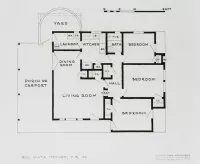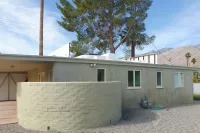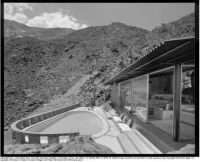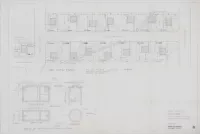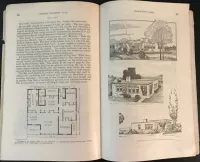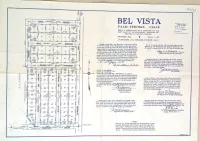Share what you know,
and discover more.
Share what you know,
and discover more.
Aug 26, 2020
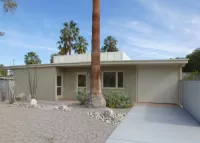
-

- Dave D
Unpretentious Home Has a Rich History
Unpretentious Home Has a Rich History by Dave Weinstein When architecture fans in the desert think about Albert Frey, spectacular objects come to mind. His Tramway Gas Station (now the Palm Springs Visitors Center) seeks to take flight beneath its soaring paraboloid roof. To his Frey House 1 the architect added a circular bedroom with circular windows that suggests a spaceship. His Frey House II, perched on the side of a mountain, has immense rock outcrops pushing through its living spaces. His Bel Vista House, at 1520 East Tachevah Drive, which was named this month to the National Register of Historic Places, makes clear however that the work of Frey (1903-1998) was substance even when it was not show. What could be less pretentious than this flat-roofed, three-bedroom home built on a concrete slab and with only 1,100 square feet of space? But look closely to see thoughtful innovations to make this home comfortable in the harsh desert clime for working people who were its intended buyers. "It is simple, yet has a few very significant details minimal houses at the time did not,” says Todd Hays, who owns the house and nominated it to the Register. “Most notably, its seven doors. Houses at the time might have two, some just one. And it has one of the very first examples of a double door set.” The many doors do much to open the house to the out of doors, deep overhangs help cool things down – and how many compact houses provide three covered porches? “Its curved block wall is another significant character-defining feature,” Hays says, adding of the home, “Simple, yet significant.” The curved wall was designed functionally enough to hide the clothesline. One reason for the significance of the Bel Vista home: it was part of a small tract of modernist homes – perhaps the first tract of modern homes in the United States, or at least one of the first. Bel Vista was designed in 1945 and opened in 1946. “Bel Vista is one of the earliest postwar housing tracts built in Palm Springs and its only early modern-style subdivision,” Hays writes. Joe Eichler, another pioneering builder of modern tract homes, opened his first tract of modern homes three years later, in 1949 in Sunnyvale. Hays, a real estate agent, already owned another of the Bel Vista homes when this one came on the market. “I had no interest in buying it,” Hays says. “Everybody looking at it was talking about tearing the house down because it was a nothing house. It was clear to me that what was most likely going to happen was somebody would buy the house and tear it down, and I didn’t want that to happen.” So he bought it and later sold his first Frey home, which was not as original. He also got local historic designation for his new home, which offers strong protections. “I wanted it protected essentially for all time,” Hays says. Over the years Bel Vista seems to have dropped out of history, probably because the other homes in the tract were so remodeled they disappeared. Fifteen of the homes were built by developers Culver Nichols and Sallie Stevens Nichols and Frey himself, with financing from the Home Owners Loan Corporation. Even though Bel Vista is discussed and illustrated in Joseph Rosa’s 1999 book ‘Albert Frey, Architect,’ when the first Frey house Hays owned came on the market, “there was no recognition of it being an Albert Frey. The doors and windows had been changed, and it was kind of a skanky little house." When someone informed the listing agent it was by Frey, Hays took interest, bought it, then researched Frey and the neighborhood. Could the rest of the tract be restored? “Sadly, it would be difficult,” Hays says. “It wouldn’t be impossible, two or three of them maybe. Most of them are literally unrecognizable.” Frey, a Swiss man who had worked for Le Corbusier, a proponent of worker’s housing, had designed farmworker houses when he worked for the federal Department of Agriculture in the 1930s, and co-authored an article on the subject, with his partner A. Lawrence Kocher, “Real Estate Subdivisions for Low-Cost Housing.” “In the article,” Hays says, “they advocated how economical housing solutions could be realized on a small, square lot and eliminate monotony by placing one standard house plan in a staggered arrangement from lot to lot.” He writes: “Originally planned as a tract of affordable war workers’ housing, Frey’s goal was to devise a plan that was both affordable and created distinct identities for each home at street-front. The simple solution called for one single plan to be flipped, rotated, and placed with an altered setback from lot to lot.” “It’s a very important house, a house produced for the masses,” Hays says, adding, “This was the very first and only built example of what Frey was trying to do for years and years and years.”
Unpretentious Home Has a Rich History
Unpretentious Home Has a Rich History by Dave Weinstein When architecture fans in the desert think about Albert Frey, spectacular objects come to mind. His Tramway Gas Station (now the Palm Springs Visitors Center) seeks to take flight beneath its soaring paraboloid roof. To his Frey House 1 the architect added a circular bedroom with circular windows that suggests a spaceship. His Frey House II, perched on the side of a mountain, has immense rock outcrops pushing through its living spaces. His Bel Vista House, at 1520 East Tachevah Drive, which was named this month to the National Register of Historic Places, makes clear however that the work of Frey (1903-1998) was substance even when it was not show. What could be less pretentious than this flat-roofed, three-bedroom home built on a concrete slab and with only 1,100 square feet of space? But look closely to see thoughtful innovations to make this home comfortable in the harsh desert clime for working people who were its intended buyers. "It is simple, yet has a few very significant details minimal houses at the time did not,” says Todd Hays, who owns the house and nominated it to the Register. “Most notably, its seven doors. Houses at the time might have two, some just one. And it has one of the very first examples of a double door set.” The many doors do much to open the house to the out of doors, deep overhangs help cool things down – and how many compact houses provide three covered porches? “Its curved block wall is another significant character-defining feature,” Hays says, adding of the home, “Simple, yet significant.” The curved wall was designed functionally enough to hide the clothesline. One reason for the significance of the Bel Vista home: it was part of a small tract of modernist homes – perhaps the first tract of modern homes in the United States, or at least one of the first. Bel Vista was designed in 1945 and opened in 1946. “Bel Vista is one of the earliest postwar housing tracts built in Palm Springs and its only early modern-style subdivision,” Hays writes. Joe Eichler, another pioneering builder of modern tract homes, opened his first tract of modern homes three years later, in 1949 in Sunnyvale. Hays, a real estate agent, already owned another of the Bel Vista homes when this one came on the market. “I had no interest in buying it,” Hays says. “Everybody looking at it was talking about tearing the house down because it was a nothing house. It was clear to me that what was most likely going to happen was somebody would buy the house and tear it down, and I didn’t want that to happen.” So he bought it and later sold his first Frey home, which was not as original. He also got local historic designation for his new home, which offers strong protections. “I wanted it protected essentially for all time,” Hays says. Over the years Bel Vista seems to have dropped out of history, probably because the other homes in the tract were so remodeled they disappeared. Fifteen of the homes were built by developers Culver Nichols and Sallie Stevens Nichols and Frey himself, with financing from the Home Owners Loan Corporation. Even though Bel Vista is discussed and illustrated in Joseph Rosa’s 1999 book ‘Albert Frey, Architect,’ when the first Frey house Hays owned came on the market, “there was no recognition of it being an Albert Frey. The doors and windows had been changed, and it was kind of a skanky little house." When someone informed the listing agent it was by Frey, Hays took interest, bought it, then researched Frey and the neighborhood. Could the rest of the tract be restored? “Sadly, it would be difficult,” Hays says. “It wouldn’t be impossible, two or three of them maybe. Most of them are literally unrecognizable.” Frey, a Swiss man who had worked for Le Corbusier, a proponent of worker’s housing, had designed farmworker houses when he worked for the federal Department of Agriculture in the 1930s, and co-authored an article on the subject, with his partner A. Lawrence Kocher, “Real Estate Subdivisions for Low-Cost Housing.” “In the article,” Hays says, “they advocated how economical housing solutions could be realized on a small, square lot and eliminate monotony by placing one standard house plan in a staggered arrangement from lot to lot.” He writes: “Originally planned as a tract of affordable war workers’ housing, Frey’s goal was to devise a plan that was both affordable and created distinct identities for each home at street-front. The simple solution called for one single plan to be flipped, rotated, and placed with an altered setback from lot to lot.” “It’s a very important house, a house produced for the masses,” Hays says, adding, “This was the very first and only built example of what Frey was trying to do for years and years and years.”
Aug 26, 2020
Unpretentious Home Has a Rich History
Unpretentious Home Has a Rich History by Dave WeinsteinWhen architecture fans in the desert think about Albert Frey, spectacular objects come to mind.
His Tramway Gas Station (now the Palm Springs Visitors Center) seeks to take flight beneath its soaring paraboloid roof.
To his Frey House 1 the architect added a circular bedroom with circular windows that suggests a spaceship. His Frey House II, perched on the side of a mountain, has immense rock outcrops pushing through its living spaces.
His Bel Vista House, at 1520 East Tachevah Drive, which was named this month to the National Register of Historic Places, makes clear however that the work of Frey (1903-1998) was substance even when it was not show.
What could be less pretentious than this flat-roofed, three-bedroom home built on a concrete slab and with only 1,100 square feet of space? But look closely to see thoughtful innovations to make this home comfortable in the harsh desert clime for working people who were its intended buyers.
"It is simple, yet has a few very significant details minimal houses at the time did not,” says Todd Hays, who owns the house and nominated it to the Register. “Most notably, its seven doors. Houses at the time might have two, some just one. And it has one of the very first examples of a double door set.”
The many doors do much to open the house to the out of doors, deep overhangs help cool things down – and how many compact houses provide three covered porches?
“Its curved block wall is another significant character-defining feature,” Hays says, adding of the home, “Simple, yet significant.” The curved wall was designed functionally enough to hide the clothesline.
One reason for the significance of the Bel Vista home: it was part of a small tract of modernist homes – perhaps the first tract of modern homes in the United States, or at least one of the first. Bel Vista was designed in 1945 and opened in 1946.
“Bel Vista is one of the earliest postwar housing tracts built in Palm Springs and its only early modern-style subdivision,” Hays writes.
Joe Eichler, another pioneering builder of modern tract homes, opened his first tract of modern homes three years later, in 1949 in Sunnyvale.
Hays, a real estate agent, already owned another of the Bel Vista homes when this one came on the market.
“I had no interest in buying it,” Hays says. “Everybody looking at it was talking about tearing the house down because it was a nothing house. It was clear to me that what was most likely going to happen was somebody would buy the house and tear it down, and I didn’t want that to happen.”
So he bought it and later sold his first Frey home, which was not as original. He also got local historic designation for his new home, which offers strong protections. “I wanted it protected essentially for all time,” Hays says.
Over the years Bel Vista seems to have dropped out of history, probably because the other homes in the tract were so remodeled they disappeared. Fifteen of the homes were built by developers Culver Nichols and Sallie Stevens Nichols and Frey himself, with financing from the Home Owners Loan Corporation.
Even though Bel Vista is discussed and illustrated in Joseph Rosa’s 1999 book ‘Albert Frey, Architect,’ when the first Frey house Hays owned came on the market, “there was no recognition of it being an Albert Frey. The doors and windows had been changed, and it was kind of a skanky little house."
When someone informed the listing agent it was by Frey, Hays took interest, bought it, then researched Frey and the neighborhood.
Could the rest of the tract be restored? “Sadly, it would be difficult,” Hays says. “It wouldn’t be impossible, two or three of them maybe. Most of them are literally unrecognizable.”
Frey, a Swiss man who had worked for Le Corbusier, a proponent of worker’s housing, had designed farmworker houses when he worked for the federal Department of Agriculture in the 1930s, and co-authored an article on the subject, with his partner A. Lawrence Kocher, “Real Estate Subdivisions for Low-Cost Housing.”
“In the article,” Hays says, “they advocated how economical housing solutions could be realized on a small, square lot and eliminate monotony by placing one standard house plan in a staggered arrangement from lot to lot.”
He writes: “Originally planned as a tract of affordable war workers’ housing, Frey’s goal was to devise a plan that was both affordable and created distinct identities for each home at street-front. The simple solution called for one single plan to be flipped, rotated, and placed with an altered setback from lot to lot.”
“It’s a very important house, a house produced for the masses,” Hays says, adding, “This was the very first and only built example of what Frey was trying to do for years and years and years.”
Posted Date
Dec 18, 2021
Historical Record Date
Aug 26, 2020
Source Name
Eichler Network
Delete Story
Are you sure you want to delete this story?
Mar 13, 2020
Mar 13, 2020
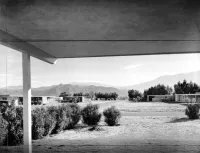
-

- Dave D
National Register of Historic Places - Summary
Summary Paragraph The International Style south-facing Bel Vista House was constructed in 1946 as one of fifteen identical homes in the Bel Vista tract. Set in the center of an approximately quarter-acre corner lot, the one-story building is modest in size at 1,110 square feet. Located on the northeast corner of a block at the southern entry to the original tract, the property is on the main thoroughfare in central Palm Springs surrounded by a residential neighborhood consisting of one-story, single-family residential buildings. The house exhibits architectural elements associated with the work of Albert Frey, including a concrete slab foundation, flat roof, deep eaves with wood fascia, painted stucco, wood casement windows, a rear curvilinear block wall built to contain clotheslines, and slender wood posts supporting a cantilevered carport roof. Construction is of standard wood frame with wood lath and stucco. All windows are wood casement style. The glazed front door and all exterior doors are of a unique bi-pane design. A noncontributing pool was added post-period of significance in the northwest corner of the property. A corrugated metal fence borders the south and west sides of the property. The building is in excellent condition and retains all aspects of integrity.
National Register of Historic Places - Summary
Summary Paragraph The International Style south-facing Bel Vista House was constructed in 1946 as one of fifteen identical homes in the Bel Vista tract. Set in the center of an approximately quarter-acre corner lot, the one-story building is modest in size at 1,110 square feet. Located on the northeast corner of a block at the southern entry to the original tract, the property is on the main thoroughfare in central Palm Springs surrounded by a residential neighborhood consisting of one-story, single-family residential buildings. The house exhibits architectural elements associated with the work of Albert Frey, including a concrete slab foundation, flat roof, deep eaves with wood fascia, painted stucco, wood casement windows, a rear curvilinear block wall built to contain clotheslines, and slender wood posts supporting a cantilevered carport roof. Construction is of standard wood frame with wood lath and stucco. All windows are wood casement style. The glazed front door and all exterior doors are of a unique bi-pane design. A noncontributing pool was added post-period of significance in the northwest corner of the property. A corrugated metal fence borders the south and west sides of the property. The building is in excellent condition and retains all aspects of integrity.
National Register of Historic Places - Summary
Summary ParagraphThe International Style south-facing Bel Vista House was constructed in 1946 as one of fifteen identical homes in the Bel Vista tract. Set in the center of an approximately quarter-acre corner lot, the one-story building is modest in size at 1,110 square feet. Located on the northeast corner of a block at the southern entry to the original tract, the property is on the main thoroughfare in central Palm Springs surrounded by a residential neighborhood consisting of one-story, single-family residential buildings. The house exhibits architectural elements associated with the work of Albert Frey, including a concrete slab foundation, flat roof, deep eaves with wood fascia, painted stucco, wood casement windows, a rear curvilinear block wall built to contain clotheslines, and slender wood posts supporting a cantilevered carport roof. Construction is of standard wood frame with wood lath and stucco. All windows are wood casement style. The glazed front door and all exterior doors are of a unique bi-pane design. A noncontributing pool was added post-period of significance in the northwest corner of the property. A corrugated metal fence borders the south and west sides of the property. The building is in excellent condition and retains all aspects of integrity.
Posted Date
Dec 18, 2021
Historical Record Date
Mar 13, 2020
Source Name
United States Department of the Interior - National Park Service
Delete Story
Are you sure you want to delete this story?


